Sadly, Prof. Emeritus Winthrop W. Smith passed away in Peabody, MA on April 7, 2025, with his devoted daughter Sarah by his side. After growing up in New Jersey, Win received his undergraduate and graduate degrees in physics from Amherst and MIT, respectively, and then undertook postdoctoral work at the Joint Institute of Laboratory Astrophysics (JILA) in Boulder, Colorado, where he met his late wife Anne. He began his academic journey at Columbia University, in New York City, eventually transitioning to the University of Connecticut, where he spent a long and illustrious career teaching and performing research in physics, officially retiring in 2009.
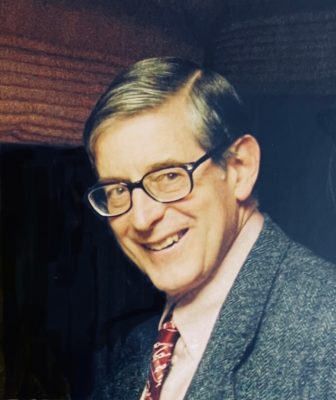 Win’s research was primarily in the field of atomic, molecular, and optical (AMO) physics. The systems he studied covered a diverse range, including: electrons; ions (both positive and negative); atoms; molecules; and photons. They also spanned a wide spectrum of energies, from relativistic to ultracold. His experiments employed a variety of tools, such as lasers, spectrometers, particle beams, accelerators, and traps for atoms and ions. Win investigated many interesting topics, including: charge-exchange collisions; highly-charged ions; molecular spectroscopy; collision-induced x-ray emission; relativistic negative ion beams; atom interferometry; linear rf traps for ions; and nonlinear dynamics (chaos). He was very productive, with his work resulting in over 100 journal publications. His latest research, performed mainly after officially retiring, involved interactions between overlapping samples of trapped ions and ultracold neutral atoms, and garnered significant attention.
Win’s research was primarily in the field of atomic, molecular, and optical (AMO) physics. The systems he studied covered a diverse range, including: electrons; ions (both positive and negative); atoms; molecules; and photons. They also spanned a wide spectrum of energies, from relativistic to ultracold. His experiments employed a variety of tools, such as lasers, spectrometers, particle beams, accelerators, and traps for atoms and ions. Win investigated many interesting topics, including: charge-exchange collisions; highly-charged ions; molecular spectroscopy; collision-induced x-ray emission; relativistic negative ion beams; atom interferometry; linear rf traps for ions; and nonlinear dynamics (chaos). He was very productive, with his work resulting in over 100 journal publications. His latest research, performed mainly after officially retiring, involved interactions between overlapping samples of trapped ions and ultracold neutral atoms, and garnered significant attention.
Over the years, Win taught and trained a large number of undergraduates, graduate students, and postdoctoral researchers, and was a valued mentor to younger faculty. In terms of classroom teaching, Win’s portfolio encompassed multiple areas of physics: classical mechanics; electricity & magnetism; quantum mechanics; atomic physics; optics; lasers; electronics; and introductory physics for various audiences. He took great pleasure in motivating his students and seeing them learn.
Win was heavily involved in the American Physical Society (APS), serving as an officer in the New England Section (NES), the Division of Atomic, Molecular and Optical Physics (DAMOP), and the Division of Laser Science (DLS). He also played a key role in organizing several large physics conferences in Storrs: DAMOP Annual Meetings in 1984 and 2000; and the International Conference on Atomic Physics (ICAP) in 2008. Win spent a year as a Program Officer for the National Science Foundation, helping set funding priorities for AMO Physics. He also performed significant service for the Department and University, serving in the University Senate, as President of the UConn Chapter of the American Association of University Professors (AAUP), and as a member and chair of many committees.
Win enjoyed traveling and collaborating with colleagues and thereby embarked on several sabbaticals: JILA, Stanford, Munich, Aarhus, MIT, and the Harvard-Smithsonian Center for Astrophysics. He also worked with colleagues at various national labs: Los Alamos in New Mexico, Oak Ridge in Tennessee, Lawrence Livermore in California, and the Jet Propulsion Lab in Pasadena.
Win’s accomplishments earned him several honors. He received Fellowship in the American Physical Society, an Alexander von Humboldt Senior Scientist Research Award to work in Germany, and Membership in the Connecticut Academy of Science and Engineering.
Interestingly, his great-uncle, Percy Bridgman, a professor at Harvard, won the 1946 Nobel Prize in Physics for his work in high-pressure physics, leaving a strong impression on the young Win.
Win had many outside interests including: music, singing in the Hartford Chorale and the UConn Festival Chorus; and hiking and skiing in the White Mountains near Randolph, New Hampshire. He was passionately interested in politics, serving locally on the Mansfield Town Ethics Board and Democratic Town Committee.
Win will be greatly missed, and fondly remembered, by the Physics Department. In his memory, donations can be made to the Anne and Win Smith Fellowship Fund for support of graduate students in physics, or the American Civil Liberties Union (ACLU).
 Win’s research was primarily in the field of atomic, molecular, and optical (AMO) physics. The systems he studied covered a diverse range, including: electrons; ions (both positive and negative); atoms; molecules; and photons. They also spanned a wide spectrum of energies, from relativistic to ultracold. His experiments employed a variety of tools, such as lasers, spectrometers, particle beams, accelerators, and traps for atoms and ions. Win investigated many interesting topics, including: charge-exchange collisions; highly-charged ions; molecular spectroscopy; collision-induced x-ray emission; relativistic negative ion beams; atom interferometry; linear rf traps for ions; and nonlinear dynamics (chaos). He was very productive, with his work resulting in over 100 journal publications. His latest research, performed mainly after officially retiring, involved interactions between overlapping samples of trapped ions and ultracold neutral atoms, and garnered significant attention.
Win’s research was primarily in the field of atomic, molecular, and optical (AMO) physics. The systems he studied covered a diverse range, including: electrons; ions (both positive and negative); atoms; molecules; and photons. They also spanned a wide spectrum of energies, from relativistic to ultracold. His experiments employed a variety of tools, such as lasers, spectrometers, particle beams, accelerators, and traps for atoms and ions. Win investigated many interesting topics, including: charge-exchange collisions; highly-charged ions; molecular spectroscopy; collision-induced x-ray emission; relativistic negative ion beams; atom interferometry; linear rf traps for ions; and nonlinear dynamics (chaos). He was very productive, with his work resulting in over 100 journal publications. His latest research, performed mainly after officially retiring, involved interactions between overlapping samples of trapped ions and ultracold neutral atoms, and garnered significant attention.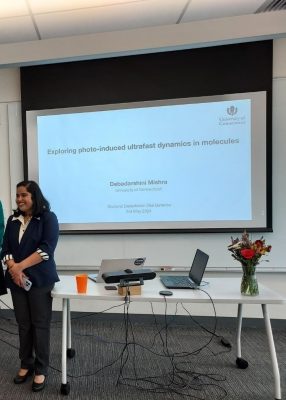 Debadarshini (Jolly) Mishra successfully defended her PhD thesis in May 2024 in Atomic, Molecular and Optical Physics. Jolly gave several presentations at national and international conferences and is the co-author of 8 publications. She is now a postdoc at Lawrence Berkeley National Lab and was hired before her thesis defense to contribute her research and learn new research techniques.
Debadarshini (Jolly) Mishra successfully defended her PhD thesis in May 2024 in Atomic, Molecular and Optical Physics. Jolly gave several presentations at national and international conferences and is the co-author of 8 publications. She is now a postdoc at Lawrence Berkeley National Lab and was hired before her thesis defense to contribute her research and learn new research techniques.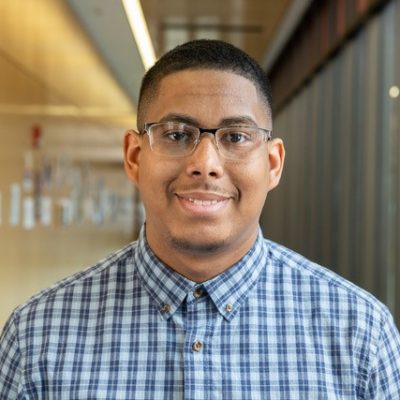 As part of his Ph.D. project, Jonathan Mercedes-Feliz has made very important contributions to our understanding of the interplay between supermassive black holes and galaxies using state-of-the-art supercomputing simulations that for the first time model the propagation and impact of powerful black hole-driven winds from the very center of galaxies all the way to the intergalactic medium. Using novel data analysis approaches, Jonathan has shown that these powerful winds can simultaneously enhance the rate of formation of stars in localized regions while dramatically suppressing the global growth of massive galaxies, explaining seemingly contradictory results from recent observations and previous theoretical models. Besides excelling in research, Jonathan is deeply committed to advancing diversity, equity, and inclusion, and he has been an invaluable mentor for undergraduate and high school students from historically excluded groups as part of the McNair Scholars program, the Center for Access and Postsecondary Success (CAPS) Summer Program, and the YSSS Jack Kent Cooke Scholars program at UConn. With his published Ph.D. work already attracting significant attention in the community, Jonathan has accepted a postdoctoral research position funded by the NASA Astrophysics Theory Program to lead the next generation of simulations modeling the co-evolution of black holes and galaxies as part of Prof. Anglés-Alcázar’s group at the University of Connecticut.
As part of his Ph.D. project, Jonathan Mercedes-Feliz has made very important contributions to our understanding of the interplay between supermassive black holes and galaxies using state-of-the-art supercomputing simulations that for the first time model the propagation and impact of powerful black hole-driven winds from the very center of galaxies all the way to the intergalactic medium. Using novel data analysis approaches, Jonathan has shown that these powerful winds can simultaneously enhance the rate of formation of stars in localized regions while dramatically suppressing the global growth of massive galaxies, explaining seemingly contradictory results from recent observations and previous theoretical models. Besides excelling in research, Jonathan is deeply committed to advancing diversity, equity, and inclusion, and he has been an invaluable mentor for undergraduate and high school students from historically excluded groups as part of the McNair Scholars program, the Center for Access and Postsecondary Success (CAPS) Summer Program, and the YSSS Jack Kent Cooke Scholars program at UConn. With his published Ph.D. work already attracting significant attention in the community, Jonathan has accepted a postdoctoral research position funded by the NASA Astrophysics Theory Program to lead the next generation of simulations modeling the co-evolution of black holes and galaxies as part of Prof. Anglés-Alcázar’s group at the University of Connecticut.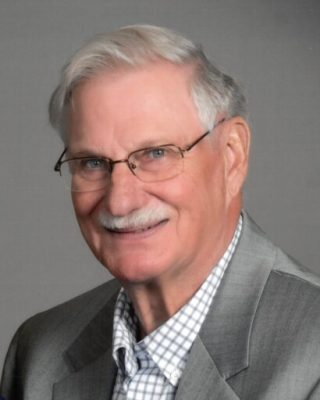 Lawrence “Larry” Kappers, passed away on Friday, August 2, 2024. Professor Lawrence (Larry) Kappers (aka “Kap”) retired in 2009, having joined the UConn Physics Department in 1973. After receiving his Ph.D. from the University of Missouri-Columbia and completing postdoctoral appointments at the University of Minnesota and Oklahoma State University, he developed an active research program in the optical and ESR spectroscopy of color-centers in inorganic insulators. Larry later became interested in the optical properties of 3d ions at high pressure and developed a diamond-anvil cell to complete the spectroscopic measurements. He was especially proud of his service to the department as director of the Perkin-Elmer Program, which led to a Masters degree in Physics with a concentration in optics, and also his involvement with the collaborative program between the physics department and the Institute for Crystal Physics in Budapest, Hungary. Larry continued his productive research contributions with a project funded by Radiation Monitoring Devices, Inc. on the luminescent properties of scintillator materials.
Lawrence “Larry” Kappers, passed away on Friday, August 2, 2024. Professor Lawrence (Larry) Kappers (aka “Kap”) retired in 2009, having joined the UConn Physics Department in 1973. After receiving his Ph.D. from the University of Missouri-Columbia and completing postdoctoral appointments at the University of Minnesota and Oklahoma State University, he developed an active research program in the optical and ESR spectroscopy of color-centers in inorganic insulators. Larry later became interested in the optical properties of 3d ions at high pressure and developed a diamond-anvil cell to complete the spectroscopic measurements. He was especially proud of his service to the department as director of the Perkin-Elmer Program, which led to a Masters degree in Physics with a concentration in optics, and also his involvement with the collaborative program between the physics department and the Institute for Crystal Physics in Budapest, Hungary. Larry continued his productive research contributions with a project funded by Radiation Monitoring Devices, Inc. on the luminescent properties of scintillator materials.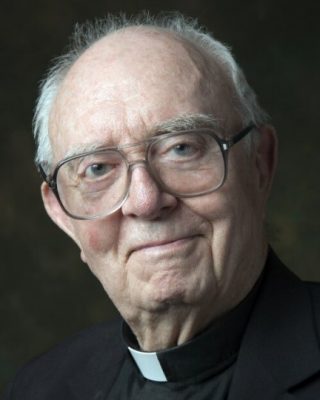 Father Thaddeus J. Burch passed away May 14, 2024 in Wauwatosa, WI. He was 93 years old, a Jesuit for 75 years and a priest for 62 years. His life combined his deep religious faith with a quest and appreciation for the world of physics. In addition to his two bachelor’s degrees in philosophy and theology, he earned bachelor’s and master’s degrees in physics and then a PhD at Fordham University. His PhD thesis on “A Nuclear Resonance Study of Order-Disorder in Ferromagnetic Alloys” was completed in 1968 under the direction of Professor Joseph Budnick. In 1974, Joe left Fordham to become the department chair in physics at the University of Connecticut and Thaddeus joined him as a visiting professor and a member of the Institute of Materials Sciences from 1974 to 1976. The research they completed together over the years led to 41 peer-reviewed journal articles that used NMR to probe ferromagnetic materials. Father Burch later joined Marquette University and was a professor of physics, physics department chair, and dean of the graduate school. Professor Budnick remembers Father Burch as “a dedicated and gifted student at Fordham and a creative and interactive researcher in the lab. He was a genuinely wonderful person in every way.”
Father Thaddeus J. Burch passed away May 14, 2024 in Wauwatosa, WI. He was 93 years old, a Jesuit for 75 years and a priest for 62 years. His life combined his deep religious faith with a quest and appreciation for the world of physics. In addition to his two bachelor’s degrees in philosophy and theology, he earned bachelor’s and master’s degrees in physics and then a PhD at Fordham University. His PhD thesis on “A Nuclear Resonance Study of Order-Disorder in Ferromagnetic Alloys” was completed in 1968 under the direction of Professor Joseph Budnick. In 1974, Joe left Fordham to become the department chair in physics at the University of Connecticut and Thaddeus joined him as a visiting professor and a member of the Institute of Materials Sciences from 1974 to 1976. The research they completed together over the years led to 41 peer-reviewed journal articles that used NMR to probe ferromagnetic materials. Father Burch later joined Marquette University and was a professor of physics, physics department chair, and dean of the graduate school. Professor Budnick remembers Father Burch as “a dedicated and gifted student at Fordham and a creative and interactive researcher in the lab. He was a genuinely wonderful person in every way.”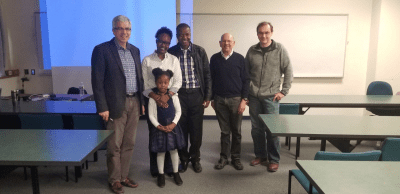
 Prof. Strickland is one of the recipients of the 2018 Nobel Prize in Physics for developing
Prof. Strickland is one of the recipients of the 2018 Nobel Prize in Physics for developing